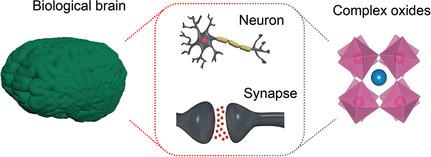当前位置:
X-MOL 学术
›
Adv. Mater.
›
论文详情
Our official English website, www.x-mol.net, welcomes your
feedback! (Note: you will need to create a separate account there.)
Complex Oxides for Brain-Inspired Computing: A Review
Advanced Materials ( IF 27.4 ) Pub Date : 2022-06-20 , DOI: 10.1002/adma.202203352 Tae Joon Park 1 , Sunbin Deng 1 , Sukriti Manna 2 , A N M Nafiul Islam 3 , Haoming Yu 1 , Yifan Yuan 1 , Dillon D Fong 4 , Alexander A Chubykin 5 , Abhronil Sengupta 3 , Subramanian K R S Sankaranarayanan 2, 6 , Shriram Ramanathan 1
Advanced Materials ( IF 27.4 ) Pub Date : 2022-06-20 , DOI: 10.1002/adma.202203352 Tae Joon Park 1 , Sunbin Deng 1 , Sukriti Manna 2 , A N M Nafiul Islam 3 , Haoming Yu 1 , Yifan Yuan 1 , Dillon D Fong 4 , Alexander A Chubykin 5 , Abhronil Sengupta 3 , Subramanian K R S Sankaranarayanan 2, 6 , Shriram Ramanathan 1
Affiliation

|
The fields of brain-inspired computing, robotics, and, more broadly, artificial intelligence (AI) seek to implement knowledge gleaned from the natural world into human-designed electronics and machines. In this review, the opportunities presented by complex oxides, a class of electronic ceramic materials whose properties can be elegantly tuned by doping, electron interactions, and a variety of external stimuli near room temperature, are discussed. The review begins with a discussion of natural intelligence at the elementary level in the nervous system, followed by collective intelligence and learning at the animal colony level mediated by social interactions. An important aspect highlighted is the vast spatial and temporal scales involved in learning and memory. The focus then turns to collective phenomena, such as metal-to-insulator transitions (MITs), ferroelectricity, and related examples, to highlight recent demonstrations of artificial neurons, synapses, and circuits and their learning. First-principles theoretical treatments of the electronic structure, and in situ synchrotron spectroscopy of operating devices are then discussed. The implementation of the experimental characteristics into neural networks and algorithm design is then revewed. Finally, outstanding materials challenges that require a microscopic understanding of the physical mechanisms, which will be essential for advancing the frontiers of neuromorphic computing, are highlighted.
中文翻译:

用于类脑计算的复合氧化物:综述
类脑计算、机器人技术以及更广泛的人工智能 (AI) 领域寻求将从自然世界收集的知识应用到人类设计的电子产品和机器中。在这篇综述中,讨论了复合氧化物带来的机遇,复合氧化物是一类电子陶瓷材料,其性能可以通过掺杂、电子相互作用和接近室温的各种外部刺激来优雅地调节。这篇综述首先讨论神经系统初级水平的自然智力,然后讨论由社会互动介导的动物群体水平的集体智力和学习。强调的一个重要方面是学习和记忆涉及的广阔的空间和时间尺度。然后,焦点转向集体现象,例如金属到绝缘体转变 (MIT)、铁电性和相关示例,以强调最近的人工神经元、突触和电路及其学习的演示。然后讨论了电子结构的第一性原理理论处理以及操作装置的原位同步加速器光谱。然后回顾了实验特征在神经网络和算法设计中的实现。最后,强调了需要对物理机制进行微观理解的突出材料挑战,这对于推进神经形态计算的前沿至关重要。
更新日期:2022-06-20
中文翻译:

用于类脑计算的复合氧化物:综述
类脑计算、机器人技术以及更广泛的人工智能 (AI) 领域寻求将从自然世界收集的知识应用到人类设计的电子产品和机器中。在这篇综述中,讨论了复合氧化物带来的机遇,复合氧化物是一类电子陶瓷材料,其性能可以通过掺杂、电子相互作用和接近室温的各种外部刺激来优雅地调节。这篇综述首先讨论神经系统初级水平的自然智力,然后讨论由社会互动介导的动物群体水平的集体智力和学习。强调的一个重要方面是学习和记忆涉及的广阔的空间和时间尺度。然后,焦点转向集体现象,例如金属到绝缘体转变 (MIT)、铁电性和相关示例,以强调最近的人工神经元、突触和电路及其学习的演示。然后讨论了电子结构的第一性原理理论处理以及操作装置的原位同步加速器光谱。然后回顾了实验特征在神经网络和算法设计中的实现。最后,强调了需要对物理机制进行微观理解的突出材料挑战,这对于推进神经形态计算的前沿至关重要。











































 京公网安备 11010802027423号
京公网安备 11010802027423号